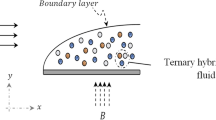Abstract
Flow measurements in ultra-pure4He through a micron-size orifice at millikelvin temperatures show the transition from thermal to quantum nucleation of nanometer-size vortices below a crossover temperature of 0.147 K. Detailed analysis, similar to that done for macroscopic quantum tunnelling in superconducting junctions, yields parameters which accurately predict the mean value and the distribution width of the critical velocities at all temperatures. These observations establish the close relationship between this type of critical flow and negative ion motion in superfluid4He and strongly suggest that the underlying mechanism is identical.
Similar content being viewed by others
References
E. Varoquaux, O. Avenel, M. Meisel,Can. J. Phys. 65, 1377 (1987).
O. Avenel, E. Varoquaux,Jpn. J. Appl. Phys. 26–3, 1798 (1987).
E. Varoquaux, W. Zimmermann, Jr., O. Avenel, inExcitations in Two-Dimensional and Three-Dimensional Quantum Fluids, ed. A.F.G. Wyatt, H.J. Lauter (Plenum Press, NY, 1991) NATO ASI Series B157 p. 343.
R.M. Bowley,J. Low Temp. Phys. 87, 137 (1992), P.V.E. McClintock, R.M. Bowley, inExcitations in Two-Dimensional and Three-Dimensional Quantum Fluids, loc. cit. p. 567.
E. Varoquaux, M.W. Meisel, O. Avenel,Phys. Rev. Lett. 57, 2291 (1986).
B.P. Beecken, W. Zimmermann, Jr.,Phys. Rev. B 35, 74, 1630 (1987).
A. Amar, Y. Sasaki, R.L. Lozez, J.C. Davis, R.E. Packard,Phys. Rev. Lett. 68, 2624 (1992).
L. Kramer,Phys. Rev. 179, 149 (1969).
V.L. Ginzburg, A.A. Sobyanin,Phys. Lett. 69A, 417 (1979) andSov. Phys. Usp. 19, 773 (1977).
J.S. Langer, J.D. Reppy,Prog. Low Temp. Phys., Vol VI, ed. C.J. Gorter (North-Holland, Amsterdam, 1970) Ch.1.
G.G. Ihas, O. Avenel, R. Aarts, R. Salmelin, E. Varoquaux, to be published inPhys. Rev. Lett., first reported at theAspen Winter Conference on Low Temperature Physics (Jan. 1992) by G.G. Ihas and at the APS Washington Meeting by O. Avenel,Bull. Am. Phys. Soc. 37, 929 (1992).
Earlier measurements5 in ultra-pure4He were too noisy to fully reveal the quantum plateau which was misinterpreted as an effect of residual3He impurities.
V.I. Mel'nikov,Phys. Reports 209, 1 (1991).
An evaluation ofT q, based on dimensional arguments, has been given by R.E. Packard, S. Vitale,Phys. Rev. 45, 2512 (1992). The agreement with the value reported here must be viewed as fortuitous as the attempt frequency ωo depends on the detailed characteristics of the potential well in which the tunnelling particle resides.
A.O. Caldeira, A.J. Leggett,Ann. Phys. (N.Y.) 149, 374 (1983).
O. Avenel, E. Varoquaux, inProc. XIth Int. Cryogenic Eng. Conf., eds. G. Klipping, I. Klipping (Butterworths, Guilford, 1986), p.587.
P. Sudraud, P. Ballongue, E. Varoquaux, O. Avenel,J. Appl. Phys. 62, 2163 (1987).
Cryogenics Consultants, operations discontinued.
Barry Controls GmbH Karl-Liebknecht-St. 30 — D-6096 Raunheim — Germany, model Al 133-15XX. The commercial mounts have been modified in the laboratory to lower the vertical cut-off frequency down to ∼ 1 Hz.
Sylomer, from Getzner Chemie GmbH, Herrenau5, A-6700 Bludenz-Bürs, Austria. This by itself provides a high frequency cut-off of ∼ 15 Hz.
Model QA-900, Sundstrand Data Control, Redmont, WA 98052 — USA.
W. Zimmermann, Jr., O. Avenel, E. Varoquaux,Physica 165&166, 749 (1990).
E. Varoquaux, O. Avenel, G. Ihas, R. Salmelin,Physica B 178, 309 (1992).
US Department of the Interior, Bureau of Mines, 1100 S. Fillmore, Amarillo, Texas 79101.
P.C. Hendry, P.V.E. McClintock,Cryogenics 27, 131 (1987).
A full study of the effect of3He on vortex nucleation will be published elsewhere.
P. Hänggi, P. Talkner, M. Borkovec,Rev. Mod. Phys. 62, 250 (1990).
A. Larkin, K.K. Likharev, Yu.N. Ovchinnikov,Physica 126B, 414 (1984).
H. Grabert, P. Olschowski, U. Weiss,Phys. Rev. B 36, 1931 (1987). We note that, as the plateau ofv c(T) is quite flat and the transition region aboutT q very narrow, we are dealing with a weakly damped system. Also, for the potential leading to eq.(4), the frequencies at the bottom and at the top of the barrier are equal.
C.M. Muirhead, W.F. Vinen, R.J. Donnelly,Phil. Trans. R. Soc. London A 311, 433 (1984) and R.J. Donnelly,Quantized Vortices in Helium II, (Cambridge Univ. Press, Cambridge, 1991) Ch.8.
E.B. Sonin,Sov. Phys. JETP 37, 494 (1974).
A.L. Fetter, inThe Physics of Liquid and Solid Helium, Part I, ed. K.H. Bennemann, J.B. Ketterson, (Wiley, NY, 1976), Ch.3.
R.N. Hills, P.H. Roberts,J. Phys. C 11, 4485 (1978), P.H. Roberts, R.N. Hills, R.J. Donnelly,Phys. Lett. 70A, 437 (1979).
J.C. Davis, J. Steinhauer, K. Schwab, Yu.M. Mukharsky, A. Amar, Y. Sasaki, R.E. Packard, preprint and this Conference.
Author information
Authors and Affiliations
Rights and permissions
About this article
Cite this article
Varoquaux, E., Ihas, G.G., Avenel, O. et al. Dissipative flow of superfluid4He through a small orifice by quantum and thermal nucleation of vortices. J Low Temp Phys 89, 207–216 (1992). https://doi.org/10.1007/BF00692593
Issue Date:
DOI: https://doi.org/10.1007/BF00692593




